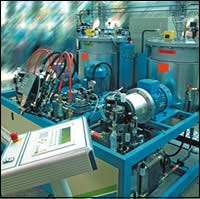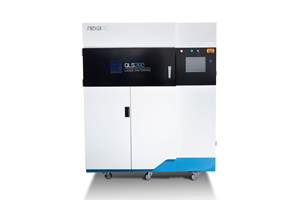K 2004 News Preview: RIM/Urethanes
New equipment at the K show will include several mixing heads for flexible foams and RIM, mixing/metering machines, a gas loading device for rigid integral-skin foaming, and a low-pressure potting unit for electrical components.New PUR materials include a new insulating foams for oil and gas pipelines, thermal encapsulation of car engines, and a steel/PUR composite for maritime and civil-engineering structures. New mixheads galoreKrauss-Maffei is unveiling new mixing heads for various PUR applications.
New equipment at the K show will include several mixing heads for flexible foams and RIM, mixing/metering machines, a gas loading device for rigid integral-skin foaming, and a low-pressure potting unit for electrical components.
New PUR materials include a new insulating foams for oil and gas pipelines, thermal encapsulation of car engines, and a steel/PUR composite for maritime and civil-engineering structures.
New mixheads galore
Krauss-Maffei is unveiling new mixing heads for various PUR applications. The MK 5/8 ULKP-2+2KV multi-component mixhead is for coloring applications such as cast skins for armrests and seat covers for airplanes and railcars, as well as shoe soles and door mats. With this unit, the color is added to the components inside the mixing chamber and not preblended with the polyol as usual. This means that only the material to be processed will be pigmented and no leftover waste will be generated. This head, which has four nozzles, is said to deliver homogeneous blends even at low output rates of 20 g/sec.
For more efficient production of sandwich components using the PUR spray molding (PSM) process, Krauss-Maffei has combined a new high-pressure linear mixing head (model MK 10 P-2KV) with a custom-built flat-spray nozzle adapter. The compressed air is metered into the viscous PUR blend in a chamber mounted on the mixhead. Atomizing takes place in front of the spray-nozzle’s discharge opening, not in the mixhead. This is said to result in output rates as much as three times higher than with previous PSM mixheads.
For rigid foams, K-M developed the ULP-2K VV G head, which has a cleaning plunger with a more powerful hydraulic drive to combat the adhesive forces that occur during processing.
For open-mold pouring as in production of refrigerator doors, K-M’s new 3B range of mixheads use impingement mixing to process hard-to-mix materials and provide turbulence-free discharge. They feature a flow divider that splits the polyol into two equal streams before it enters the mixing chamber. These streams are injected into the mixing chamber through opposing nozzles. The result is a “wall” of polyol into whose center the isocyanate stream is directed. These units also have oval injection bores with the same dimensions as the stem of the control piston, which serves to block the entry of the PUR components into the mixing chamber for an extremely short period of time in order to deliver a consistent mix. This is particularly important with smaller shot volumes.
K-M is also showing a new version of its mixhead for LFI (long-fiber injection) technology that allows for the use of natural fibers such as flax, hemp, or sisal in place of glass.
Meter/mix units upgraded
Krauss-Maffei is introducing the new EcoStar range of modular mixing/metering machines for all areas of PUR processing. The new line effectively replaces the company’s RIM-Star and RIM-Star Eco series. The EcoStar’s compact arrangement—mounted on a frame together with its control cabinet—is said to result in short conveying lines between machine components, which minimizes pressure losses, ensures more precise heat balancing, and optimizes control. Ease of operation and maintenance and improved accessibility are also claimed.
Meanwhile, the Hennecke Div. of Bayer MaterialScience is featuring a gas-loading device for low to medium nucleation in combination with its BaseLine high-pressure foaming machine for rigid integral-skin foams and compact (unfoamed) PUR systems. Integral-skin foams gain extremely fine cell structure from nucleation, while compact PUR systems benefit from the dwell pressure in the mold created by the gas, which prevents sink marks and considerably reduces trimming and finishing requirements.
Pneumatic injection control
Cannon is introducing a fully pneumatic version of its Re.Co. injection control system for its FP2L range of L-shaped, dual-chamber, high-pressure mixheads. The device was first introduced in a hydraulic version that has gained wide use in furniture, automotive, and insulation plants that produce parts containing multiple hardnesses or other formulation changes. Its claim to fame is the ability to maintain a constant pressure by monitoring and automatically adjusting the component ratio from shot to shot or during the same shot.
The new Re.Co. Air Assembly is said to offer the same level of reliability as the hydraulic version. However, it has been thoroughly redesigned to produce a very compact, simple unit that requires less maintenance and is easier to operate. Adjustment of the injector needle is now achieved through the action of a spring attached to the pneumatic piston. Needle positioning is then performed by means of a balance of the force of the spring and the opposing force generated by the material flowing into the injection nozzle.
Low-pressure potting
Cannon is featuring a new low-pressure dosing unit for encapsulation of electrical devices and components. The C2P Potting Dosing unit can mix and meter polyurethane or epoxy resin using formulations with a wide working ratio (up to 10:1), high viscosity, and very small outputs (0.2 to 1.5 g/sec). A single frame mounts day tanks, dosing unit, mixing head, and control panel. The low-pressure mixhead with remote mixing motor is said to be very lightweight and easy to handle.
PUR for pipelines
BASF is featuring three new polyurethane materials for oil and gas pipelines:
- Elastopor H is a special rigid foam formulation for insulating pipes laid at sea. It is said to keep the oil at a pumpable viscosity by minimizing heat loss from the pipe.
- Elastoshore 2570 is a solid PUR elastomer filled with glass beads for offshore oil pipelines laid at depths of 3000 meters, where “shallow-water” foams typically collapse. This formulation provides superior compressive strength plus thermal insulation due to the vacuum within the glass beads.
- Elastocoat C 6830 is a coating and casting compound that is said to provide permanent wear and corrosion protection of pipelines laid on land or at sea. It allows for the quick application on pipe joints and connecting sleeves. Hardness, density, and curing time can be matched to a job site’s conditions.
New PUR technologies
BASF will highlight the concept of thermal engine encapsulation (TEE), a developmental technology aimed at bringing PUR into the automobile engine compartment. The engine is wrapped in foam insulation in order to reduce the number of cold starts by slowing heat loss from the engine once it is switched off. Potential annual fuel savings of up to 9% in winter and 5% during the summer months are claimed. Commercial feasibility of TEE will soon be tested by a well-known manufacturer on a small diesel engine.
BASF is also showing new applications for its patented Sandwich Plate System (SPS), in which two steel plates are integrally bonded to a solid PUR elastomer core made of a BASF material called Elastocore. Since 2001, SPS has been used to repair ship’s decks and cargo holds, and maritime structures such as hull midsections of river barges. Newer applications include the funnel casing of truck ferries and replacing reinforced concrete in civil engineering structures such as road bridges. A recent application in Canada reduced the weight of a 22-meter bridge deck by 60% with SPS in place of concrete.
Related Content
PIR/PCR Recycled Content and Biobased TPEs for Broad Range of Applications
NPE2024: Kraiburg TPE launching PCR/PIR content polyolefin-based TPEs and its expanded line of Thermolast R biobased TPEs.
Read MoreEther-Based TPUs for Broad Range of Industry Applications
BASF’s Elastollan 1400 TPU series can be used for applications ranging from railway pads, hoses and profiles to show soles.
Read MoreTPEs With Higher Levels of Recycled Content
A portfolio of TPE compounds containing postconsumer and/or postindustrial recycled content from Hexpol TPE has been further expanded with grades that feature higher PCR/PIR content for various applications.
Read MoreFast-Cycling Selective Laser Sintering System
Nexa3D announced the QLS 260 for metal and polymer production.
Read MoreRead Next
Making the Circular Economy a Reality
Driven by brand owner demands and new worldwide legislation, the entire supply chain is working toward the shift to circularity, with some evidence the circular economy has already begun.
Read MoreFor PLASTICS' CEO Seaholm, NPE to Shine Light on Sustainability Successes
With advocacy, communication and sustainability as three main pillars, Seaholm leads a trade association to NPE that ‘is more active today than we have ever been.’
Read MorePeople 4.0 – How to Get Buy-In from Your Staff for Industry 4.0 Systems
Implementing a production monitoring system as the foundation of a ‘smart factory’ is about integrating people with new technology as much as it is about integrating machines and computers. Here are tips from a company that has gone through the process.
Read More























